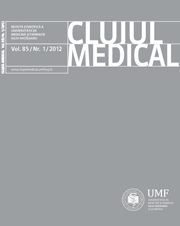Testing of a new DICOM compliant structured reporting methodology in echocardiography
Keywords:
structured reporting, standardization, DICOM, echocardiography, editing, queryAbstract
The aim of our study is to develop and test the functionality of a consistent,DICOM compliant, reporting method for diagnostic echocardiographic data,which allows through its correct structuring an exhaustive expression of diagnosticcharacteristics, and on the other hand, communication between computer systems.
Materials and methods. We developed an integrated information system andsoftware tools that have the ability to manage both DICOM images and structuredreports. We built an ontological structure and a complete set of templates that underlies structured reporting in echocardiography.
Results. We tested the reporting methodology by editing a series of 150 reports for 100 cases covering the entire pathology explored by echocardiography. The development of a unique template, to be used for the four heart valves, is the result of testing the methodology on 50 series of reports. A single template for ventricular function reporting has emerged from process testing on 50 series of reports. Reporting
echocardiographic evaluation of intracardiac masses was performed in 11 series, pathology of aorta on 10 series and pericardial collections in 7 series. Another step of the testing process was to perform complex database queries, which led to a further adjustment of the templates. The benefits of the proposed methodology has been proven through the quality of the diagnostic echocardiography report, compatible with the
highest clinical standards, the ability to support and link every diagnostic feature to a defining image, the ability to manage the large number of images from the imaging department, and by opening up great opportunities for education, research and telemedicine.
Conclusion. Following extensive testing, we achieved a structured reporting methodology form that meets the completeness criteria of the content and also the flexibility and ease of use in clinical practice.
Downloads
Published
How to Cite
Issue
Section
License
The authors are required to transfer the copyright of the published paper to the journal. This is done by agreeing to sign the Copyright Assignment Form. Whenever the case, authors are also required to send permissions to reproduce material (such as illustrations) from the copyright holder.

The papers published in the journal are licensed under a Creative Commons Attribution-NonCommercial-NoDerivatives 4.0 International License.

